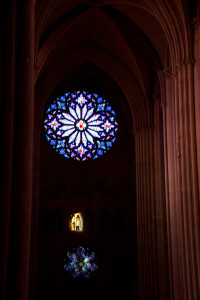Wall Street Journal, 12/11/12
By STUART ISACOFF
The annual Winter Solstice revelries at the Cathedral of St. John the Divine—feasts for the ears and eyes created by the renowned saxophonist Paul Winter for the world’s largest Anglican church—are celebrating their 33rd anniversary this week for three days beginning Thursday. And “celebration” is the word. Mr. Winter’s trademark approach embraces the sounds of the Earth—from world-class cities and third-world villages to the enchanting music of the animal kingdom—in a theatrical show that typically draws an audience of up to 2,500.
There are always dramatic surprises. In the past, Mr. Winter, who is 73, has scampered up to the rafters with his soprano saxophone to serenade audiences from above, his sweet tones swirling overhead like a gently falling snow; or featured a solo percussionist striking a giant sun-gong as player and instrument were slowly levitated 12 stories to the ceiling. Performers this year will include Mr. Winter’s musical consort, the African dance troupe Forces of Nature, griot singer Abdoulaye Diabaté from Mali, vocalist Theresa Thomason, and members of Mr. Winter’s original sextet.
His collaboration with the cathedral dates back to 1977, when its then-dean, James Parks Morton, invited him to play.
“I didn’t feel ready,” Mr. Winter said. “I had first visited the cathedral in May of 1974, for Duke Ellington’s funeral. Hearing Ella Fitzgerald sing ‘In My Solitude’ with 4,000 people in attendance was astounding. And as I left there was a recording of Johnny Hodges playing, and it sounded like it was coming from heaven. I felt that if I ever played there it would have to be something special.”
Dean Morton tried again in 1978 and then in 1979, when the two men were having lunch with tai-chi master Al Huang. Mr. Huang envisioned a dance program called “The Tao of Bach”; Mr. Winter had always wanted to present something he would call “Consorting With Bach.” On the spot, Dean Morton picked a date for their dual presentation. Since then, said Mr. Winter, his artistic residency at the church “has evolved like a garden.”
Mr. Winter’s artistic development uniquely qualifies him for that task. The early sextet with Mr. Winter on alto saxophone was a typically brash 1960s hard-swinging jazz group. But a 1962 State Department-sponsored tour of Latin America exposed the group to new ideas. In Brazil, he discovered “a new aesthetic—quiet and lyrical. There was bossa nova. We were all enthralled. We had been immersed in the testosterone-driven energy of our late teens, but this music was alluring. I wanted to find a way to play quietly without being wimpy. The saxophone player who had mastered that art was Stan Getz, and he became a big influence.”
He said he began to search for another approach to his horn. “Someone suggested Joe Allard, the dean of sax teachers, and I told him what I was looking for. ‘Do you want to play with a day sound or a night sound?’ he asked. ‘A night sound,’ I told him.
“Every lesson was about anatomy—the position of the tongue in the mouth, the relationship of the feeling in the vocal box to the pressure on the reed. And he had me change to a very strong reed. Really, I wanted to sound like a French Horn,” Mr. Winter said. “And every time I left a lesson, I’d shake my head and think, ‘I’ll never be able to do this.’”
But he did, and moved to Brazil, where his sound became further infused with what he describes as a uniquely Brazilian sense of longing. “Glad to be unhappy,” is the way he puts it. It’s a sentiment often found, he noted, in the sounds of the animal world.
Mr. Winter’s deep connection with nature might be traced to a brief stop at the Grand Canyon during his touring with that original band. “I remember sitting on the edge of the south rim of the Canyon and playing for fun,” he said, “just listening to the sound disappear in the sea of air between me and the north rim, 13 miles across.” Then, in 1967, he attended a lecture by biologist Roger Payne about whale song. “I was moved by their voices, which had a poignancy—like a cross between Miles Davis’s trumpet and an elephant. That night opened the door for me to the greater symphony of the earth.”
Later, he became engrossed by the cries of wolves. He began to integrate animal sounds into his works, often with stunning success. His recording “Common Ground” is perhaps the best-known example. The solstice celebration will include some of this.
The Winter Solstice, said Mr. Winter, is an aural tapestry of the world we share. “I’d like people to come with a sense of adventure,” he said. “I want to take them on a journey, and bring them home.”
A version of this article appeared December 11, 2012, on page A27 in the U.S. edition ofThe Wall Street Journal, with the headline: Winter’s Wonderland Is Warmer Than Ever.


Follow Paul on